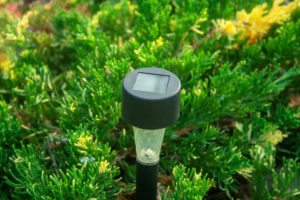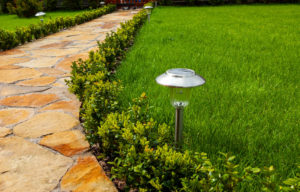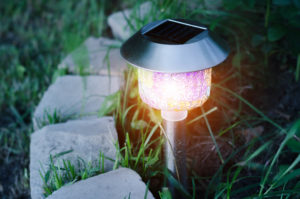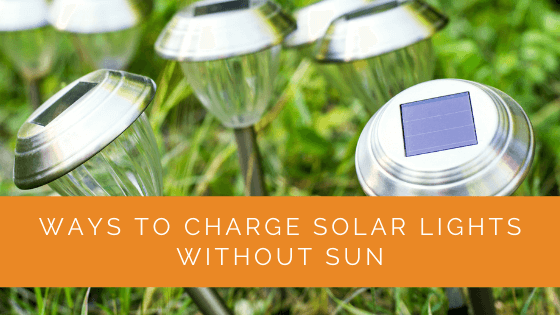Have you recently invested in an expensive solar panel setup and are now wondering if you can use solar lights without the sun? Maybe the weather won’t become sunny, and cloudy days with insufficient sunlight are on the books for weeks ahead. Not everyone lives in California! Some of us live in the other parts of the US, after all!
Don’t worry, though! Less sunlight and visible light do not mean your solar power system will stop working! On the contrary, solar batteries and outdoor solar lights can easily be powered using other methods.
If you want to find out how to charge solar lights indoors or in cloudy weather when there isn’t as much sunlight, keep reading!
Contents
- 1 Key Takeaways
- 2 Does a Solar Light Work Without Sun?
- 3 Can you Charge Solar Lights in the Shade?
- 4 Can you Charge Solar Panels Through a Window?
- 5 Can You Charge Solar Lights with Regular Lights?
- 6 How to Charge Solar Lights Without Sunlight?
- 7 How Long Should a Solar Light Be Charged?
- 8 Expert Insights From Our Solar Panel Installers About Charging Solar Lights Without Sun
- 9 Our Expertise in Solar Lights
- 10 Conclusion
Key Takeaways
- Solar lights can charge even on cloudy days or in the shade using artificial light sources like LED lamps, incandescent bulbs, and indoor lighting.
- Placing solar panels in front of a window can also help charge solar lights indoors, as visible light can be an indirect energy source.
- Regular household light bulbs, such as incandescent bulbs, can charge solar lights, making them a practical option for off-grid solar appliances.
Does a Solar Light Work Without Sun?
First of all, let’s get to the root of the issue. Can solar lights charge on a cloudy day when the sun’s rays aren’t as bright? The short answer to that is yes! Ultraviolet rays from the sun hit the photovoltaic cells on each solar panel to charge solar lights.
The solar cells respond to the natural sunlight and give you solar power to make renewable and electrical energy. However, the sun’s ultraviolet waves are not the only light sources.
Other artificial lighting systems can charge solar light. Hence, even with indirect sunlight, you can easily charge solar lights and get energy. Isn’t that a relief?
Can you Charge Solar Lights in the Shade?
When there is no outdoor light, and you need to charge a solar light, worry not! On cloudy days, you can use artificial lights as a light source to achieve the effect of full sunlight on your solar panels. You can charge your solar lights by keeping your amorphous solar panel underneath an artificial light.
Indoor lighting, such as LED lamps, incandescent, LED, and incandescent bulbs, are great artificial light sources. In addition to this, the closer the solar cells are to the LED light or the incandescent light bulbs, the faster they will charge.
You can also use various solar lighting devices to charge solar batteries. Most household lights are also a great light source. Now you can power your homes with no worries!

Can you Charge Solar Panels Through a Window?
Whether you can charge a solar light in your home through a window is quite a common question! Well, to answer it, of course, you can! However, it will be termed indoor charging since the visible light is indirect sunlight.
Solar lights work even without direct sunlight. Moreover, more sunlight doesn’t have to be the best-case scenario for harvesting energy! Solar lights without the sun work perfectly well. For the best form of solar panel charging, you should place each panel directly in front of the window.
The direct sunlight will charge solar lights even indoors, and you won’t have to use artificial lighting! It’s a win-win for everyone involved. You can now easily power any solar-powered appliances without worrying about an artificial light source.
Can You Charge Solar Lights with Regular Lights?
Another one of the artificial light sources is the regular household light bulb that is present in your home. You can charge solar lights using a lightweight solar panel using regular light. This means that an incandescent bulb can charge your solar lights.
Furthermore, solar-powered lights can be charged using most incandescent bulbs. This is excellent news for you! If you need solar flashlights for the next adventure you’re going to take, you need to know how to power off-grid solar appliances.
You can use LED flashlights or regular light bulbs to charge solar lights. If you can find a device that creates long infrared waves similar to the sun, you will notice that it will have the same effect as direct sunlight on your solar panels.
Your solar-powered flashlight will thus be powered without the use of direct sunlight. This is fantastic for the risky adventurer who wants to go off the grid!
How to Charge Solar Lights Without Sunlight?
One of the most important questions needing a direct answer is how to charge solar lights without the sun. You can do a lot, from redirecting sunlight to using light wavelengths like the sun! Here are four different ways you can charge solar lights without the sun.
Charge Each Solar Cell when There is Light During the Winters
Here’s some exciting news for you! Solar lights charge better in colder climates. That means you should use the gloomy days to charge each solar cell to its maximum capacity. You can charge solar lights without the use of direct sunlight. Bad weather doesn’t always mean bad things!
Solar panels can easily be powered up in winter when even a tiny beam of light hits the receptors on the solar panels. The PV cells respond well and can make solar energy even on dark days. So, solar is great for the summers and the rain and cloudy atmospheres.
The main reason why charging your solar lights in cold temperatures works super well is because the electrons in the solar panels do not have a lot of movement to them. This means a lot more energy production due to a higher voltage difference.
That’s a lot of science to wrap your head around! However, the bottom line is that solar panels charge incredibly well on cloudy, cold days.

Try to use Incandescent Light as Much as Possible.
If you want to charge your solar panels to the max but can’t find direct sunlight in your home, incandescent bulbs are your new best friend! You might want to use the sun’s power most of the time while charging your panels; however, it is good to be prepared for emergencies.
If you need to power your solar systems using indoor lighting, you should keep an artificial source to power your solar cells. This way, you should at least be able to charge any emergency flashlights in case of a power outage.
You need to keep another light source to help you charge your solar appliances, which can include a variety of artificial light devices to help you out. Solar lights can be powered using substitutes for the sun easily. This is incredible.
However, there is a downside to using an artificial lighting system for your solar devices. The time to charge then extends quite a bit. This means it will take more than 2 to 5 hours to charge particular solar equipment than if you were using direct light from the sun. Well, there is always a solution, though!
To rectify this, you can ensure that you keep the incandescent bulbs just a couple of inches away from the panels. This will help with the timing a ton! You don’t need to wait around all day to use your solar devices!
Try to Make Use of as Many LED Light Sources as You Can
Any solar light can be powered using an LED light system in your home. This means you can get the same result from your LED lights as you would from the sun. The cool thing about LED lights is their extensive range of various spectrums.
This means they are way more beneficial than your typical incandescent bulb. Overall, it would be best to try using LED lights as much as possible to power your solar devices.
Opt For an Alternative Method for Charging your Solar Lights
There are some solar lights out there that can be charged using alternative methods. This can include using a USB charger or even a power bank! However, this might get a bit costly for your pocket. You can use this option if you think it is the best solution.

How Long Should a Solar Light Be Charged?
To understand this question thoroughly, you must first answer a few others. Many things decide how you should charge long solar lights. A few of the points to remember are as follows:
- What is the time required for the solar light to operate?
- Precisely, what are the power of the light and the amount of energy?
- Is the energy source powerful enough or not?
After figuring this out, you can get an approximate answer. However, charging a solar device generally takes around 4 to 12 hours of full direct sunlight to make things easy for you. You can use the light for a week without needing to recharge it.
That’s the benefit of going solar!
Expert Insights From Our Solar Panel Installers About Charging Solar Lights Without Sun
Artificial light sources like LED and incandescent bulbs are a great backup for charging solar lights when sunlight is scarce. It’s a practical solution that keeps your lights functional even on the gloomiest days.
Senior Solar Technician
Placing solar panels in front of a window can harness indirect sunlight effectively. This method ensures that your solar lights continue to charge, maintaining efficiency and readiness for use.
Lead Solar Installer
Using indoor lighting, especially LED lamps, can significantly reduce the time required to charge solar lights. This method is especially useful during the winter months when sunlight is limited.
Solar Installation Specialist
Our Expertise in Solar Lights
At Solar Panels Network USA, we’re here to provide you with valuable information and support regarding solar lighting. With our experience and understanding of the solar lighting industry, our team of experts is prepared to assist you in finding the right lighting solution for your needs. Whether you’re interested in improving your outdoor spaces, conserving energy, or adopting a more sustainable approach, we’re well-equipped to help. Please feel free to contact us with any questions or inquiries.
Conclusion
One of the best things about solar lights is that they do not need the sun to operate efficiently. In addition, artificial light sources have made solar energy so much more accessible to domestic spaces.
If you are excited about using solar power to make the world clean and green again, don’t forget to share this information with all your friends!
About the Author
Solar Panels Network USA stands at the forefront of solar energy solutions, driven by a team of seasoned solar engineers and energy consultants. With over decades of experience in delivering high-quality solar installations and maintenance, we are committed to promoting sustainable energy through customer-centric, tailored solutions. Our articles reflect this commitment, crafted collaboratively by experts to provide accurate, up-to-date insights into solar technology, ensuring our readers are well-informed and empowered in their solar energy decisions.

